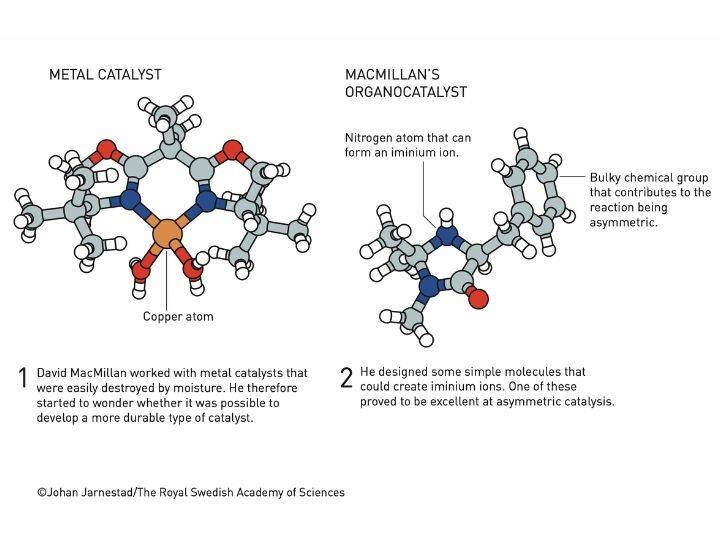Nobel Prize 2021: What Is Asymmetric Organocatalysis? Chemistry Nobel-Winning Feat EXPLAINED
The Nobel Prize 2021 in Chemistry has been jointly awarded to Benjamin List and David W.C. MacMillan ‘for the development of asymmetric organocatalysis’

New Delhi: The Royal Swedish Academy of Sciences awarded the 2021 Nobel Prize in Chemistry to Benjamin List and David W.C. MacMillan “for the development of asymmetric organocatalysis".
List and MacMillan developed organocatalysis more than two decades ago. Organocatalysis is the use of organic molecules to speed up chemical reactions.
It is a new and ingenious tool for molecule building, which is applied in developing new pharmaceuticals, and also to capture light in solar cells. It has an important role in making chemistry greener.
The discovery of asymmetric catalysis is very important because it has made it much simpler to create asymmetric molecules, taking molecular construction to an entirely new level.
Benjamin List, born in 1968, is a German scientist and Director of the Max-Planck-Institut für Kohlenforschung, Mülheim an der Ruhr, Germany. After winning the Nobel Prize, he spoke to the Nobel Committee about his work, and said, "To work with these amazing, happy and creative people; it's such a gift."
David W.C. MacMillan, born in 1968, is a British scientist and a professor at Princeton University, USA. He told the Nobel Committee that when he was notified about his win, he did not believe it initially and thought it was a prank by his students.
What Is Catalysis?
"Catalysis is incredible!" David MacMillan said in a video released by Princeton University.
Catalysis is the process of making a chemical reaction happen more quickly by using a catalyst.
"A catalyst is a substance that accelerates a chemical reaction, without itself being consumed by it", explained Abigail Doyle, A. Barton Hepburn Professor of Chemistry, in the video.
She said they are proteins, small molecules, metals and metal complexes, and that catalytic reactions surround us, drive modern society and are fuels for the chemistry of life. Photosynthesis and respiration are catalytic processes, she added.
David MacMillan explained in the same video that medicines are also made using catalysts. Also, catalysts work in the car while we drive it, he added. Catalysis is an extremely important, unbelievably fundamental aspect of the modern world, he said.
Catalytic converters clean the exhaust of automobiles, Doyle said.
MacMillan explained that the toxic fumes coming from the engine are converted into carbon-dioxide using catalysis. He concluded that people around the world, including those at Princeton University, were conducting research to find ways of converting carbon-dioxide into substances that will be beneficial to society.
Swedish chemist Jacob Berzelius wrote in the Royal Swedish Academy of Sciences' annual report that substances that can generate chemical activity had a catalytic force and named the phenomenon catalysis.
Catalysts are used to make different substances like pharmaceuticals, plastics, perfumes and food flavorings.
What Is Asymmetric Crganocatalysis?
Asymmetric organocatalysis is a type of catalysis in which a chiral catalyst (asymmetric catalyst whose chemical structure cannot be superimposed with its mirror image) speeds up the formation of a chiral compound such that the generation of one particular stereoisomer (compounds differing only in spatial arrangement of their atoms) is favoured.
Chemists are required to build new and functional molecules, which can perform a wide variety of functions like capturing light in solar cells or storing energy in batteries. These molecules can also be used to inhibit the spread of disease in the body.
The discovery by the 2021 Nobel Laureates in Chemistry has made it simpler to produce asymmetric molecules. Many chemical reactions involve the formation of substances which are mirror images of each other. For example, one version of a molecule named Limonene has a lemon scent, while its mirror image smells like an orange.
During the production of pharmaceuticals, at least one of the mirror images is formed, but there was no efficient method for this. Asymmetric organocatalysis, the concept developed by the Nobel laureates, is a simple and brilliant technique.
For a long time, just two types of catalysts were thought to be available: metals and enzymes. The 2021 Chemistry Nobel laureates independently developed asymmetric organocatalysis, which is a third type of catalyst. It builds upon small organic molecules.
Enzymes, which are a type of protein, consist of hundreds of amino acids, and are known as bio-catalysts because they catalyse biological reactions. However, not all amino acids are involved in a chemical reaction.
The ability to hold electrons or donate them makes metals excellent catalysts. However, metal catalysts are easily destroyed by moisture and oxygen, rendering them less durable as catalysts, and also, they can be harmful to the environment.
As a result, there was a need for catalysts which are safe for the environment, and asymmetric organocatalysis is the perfect solution to this problem.
Benjamin List's Research
Benjamin List worked with catalytic antibodies and observed that many enzymes catalyse chemical reactions without using metals. He asked himself a question, whether a single amino acid could catalyse a chemical reaction and thought whether an entire enzyme was necessary.
He therefore experimented on an aldol reaction, which is a reaction in which carbon atoms from two different molecules are bonded together, and used proline as a catalyst. To his surprise, the reaction worked, and proline was enough to catalyse it. The nitrogen atom in proline provides and holds electrons when a chemical reaction occurs.
He demonstrated two aspects with this experiment— one, that proline is an efficient catalyst, and two, that proline can direct asymmetric catalysis. One of the mirror images of the product was more likely to form than the other. Proline was cheap and environment-friendly. List published his discovery in February 2000, where he described asymmetric catalysis using organic molecules as one of their future aims.
David MacMillan's Study
At Harvard, MacMillan was working on improving asymmetric catalysis using metals. However, metals were sensitive and expensive, and it was complicated to conduct large-scale industrial manufacturing in oxygen-free and moisture-free conditions.
MacMillan, who worked with metal catalysts, wondered if a more durable catalyst could be developed from simple organic molecules. Hence, he started designing simple organic molecules which have the properties of metals, like accommodating electrons. Organic molecules have a stable framework of carbon atoms to which chemical groups having oxygen, nitrogen, sulphur or phosphorus could be attached.
MacMillan's organocatalyst had nitrogen atoms which form iminium ions. The nitrogen atom contained in an iminium ion has an inherent affinity for electrons. He conducted a Diels-Alder reaction, which is a reaction used to build rings of carbon atoms.
The reaction worked excellently, and one of the two possible mirror images was produced predominantly. The scientist created iminium molecules by designing some simple organic molecules, and found one of the organic molecules to work wonderfully as an asymmetric catalyst.
David MacMillan Coined The Term Organocatalysis
In order to make researchers understand that more organic catalysts could be discovered, he decided to coin a term for the concept of catalysis he had discovered. He named it, 'organocatalysis'.
He submitted the manuscript of his discovery for publication in a scientific journal, in January, 2000.
Benefits Of Organocatalysis To Humankind
Organocatalysts can work on a conveyor belt, and allow the steps in a production process to continue uninterrupted. Such a reaction, known as a cascade reaction, helps in waste reduction during chemical manufacturing.
Organocatalysis has also made molecular constructions more efficient. One such example is strychnine synthesis, which has become 7,000 times more efficient because organocatalysis builds this pesticide in a cascade reaction involving just 12 steps.
There has also been a boost in pharmaceutical research, where organocatalysts are most important. This is because, before organocatalysis, both mirror images of molecules were produced, of which only one was active and desirable, while the other produced unwanted effects.
The Thalidomide scandal, which occurred in the 1960s, is one such example. One mirror image of the thalidomide pharmaceutical caused many developing human embryos to become deformed.
Earlier, some potentially curative substances could only be isolated in meagre amounts from rare plants or deep-sea organisms. With organocatalysis, it is relatively simple to artificially produce these potentially curative substances.
In pharmaceutical companies, organocatalysis is used to produce important medicines like paroxetine, which is used to treat anxiety and depression, and the antiviral medication oseltamivir, used to treat respiratory infections.
List and MacMillan looked beyond the conventional catalysts, which is why they succeeded in the development of this cheap, simple and environment-friendly technique known as organocatalysis.






































